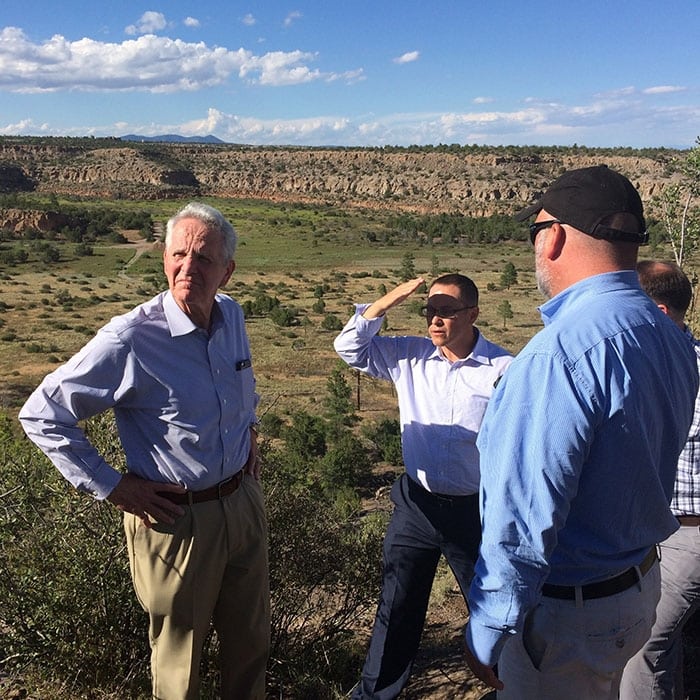
Acting Assistant Energy Secretary for Environmental Management (EM) James Owendoff was scheduled to meet with Washington state Department of Ecology Director Maia Bellon on Thursday, at least in part to discuss ideas about speeding up progress on construction of the Waste Treatment Plant (WTP) at the Hanford Site, a state official confirmed.
The visit follows a Sept. 20 letter from Owendoff to Bellon in which he cited several potential measures to expedite environmental remediation at Hanford, including accelerating conversion of liquid waste into a glass form for storage via the Direct Feed Low-Activity Waste (DFLAW) approach at the Waste Treatment Plant.
Owendoff and Associate Principal Deputy Assistant EM Secretary for Field Operations Stacy Charboneau were among the federal officials who were traveling to Ecology headquarters in Olympia, Wash., to meet with Bellon and members of her Nuclear Waste Program staff, said Ecology spokesman Randy Bradbury. Top DOE officials from the Hanford Site’s Office of River Protection and the Richland Operations Office were also expected to be on hand, Bradbury said.
Additional details of the meeting were not immediately available.
Used for decades to produce plutonium for the U.S. nuclear deterrent, the Hanford complex in southeastern Washington is home to a massive cleanup program encompassing dozens of contaminated buildings and 56 million gallons of chemical and radioactive waste stored in underground tanks that will eventually be processed for disposal.
Cleanup of the 586-square-mile facility began in 1989 and is expected to continue for decades. It had cost $36 billion by mid-2013, The Seattle Times reported.
In the correspondence obtained by Weapons Complex Monitor, Owendoff listed a number of options being considered to shorten the timeline of Hanford cleanup, including using grout within a streamlined Resource Conservation and Recovery Act process to close the C Tank Farm and treatment of some waste for shipment to the Waste Isolation Pilot Plant transuranic waste repository in New Mexico.
Owendoff focused on the potential to speed up the work of the Waste Treatment Plant: “The items under consideration include the potential acceleration of the production of low-level waste borosilicate glass through the Direct Feed Low-Activity Waste facility, involving, for example, the use of Tank Closure and Cesium Removal technology [and] on whether work on the Pretreatment Facility and High-Level Waste Facility can be paused for a short period in order to accelerate the start-up of DFLAW without impacting the Department of Energy’s ability to meet [WTP] milestones.”
The letter did not address technical specifics about the changes being contemplated or what degree of review they might have already undergone.
Owendoff has made WTP, being built by contractor Bechtel National, a major priority since becoming acting EM-1 this summer. The Energy Department has said that, once finished, WTP will be the world’s largest radioactive waste treatment plant. Glass-making vitrification technology has not previously been done on this scale, according to DOE.
But there have been schedule delays and cost overruns. The project has been estimated to cost north of $16 billion.
While processing of high-level and low-activity waste was once expected to begin together, safety issues in 2012 halted work on the WTP’s Pretreatment Facility and a large amount of work on the high-level waste facilities. The Energy Department is now pursuing the DFLAW approach, under which low-activity waste (which comprises about 90 percent of all Hanford tank waste) could be moved directly from the tank farms to the Low-Activity Waste Facility at WTP for glassification. That treatment could start in 2022, DOE says. The full plant must be operational by 2036, under a federal court order.
During a DOE event in September, longtime DOE hand Owendoff said it is vital to get the DFLAW process up and running. The Energy Department also revealed at the time that it had established a special projects unit within EM, headed by department veteran Dae Chung, to concentrate on big ticket items starting with the Waste Treatment Plant.
The department thus far hasn’t publicly released additional details about the special projects unit or the now-completed 45-day review of the Environmental Office’s operations.
The Thursday meeting was an outgrowth of the Sept. 20 letter, along with other prior discussions between Owendoff and Bellon, Bradbury said.
Owendoff talked to Bellon for about 30 minutes during an August visit by Energy Secretary Rick Perry to the Hanford Site. At the time, Owendoff mentioned some initiatives that he mentioned in his letter to Bellon, Bradbury said. Bellon listened and asked questions during the August meeting, the spokesman said.
The Department of Ecology is the state regulator for Hanford, and it has not agreed to anything at this point, Bradbury added. The state agency issues permits for DOE waste facilities in Washington. DOE would need a state permit in order to accomplish some of the items Owendoff has proposed. “We also have the Tri-Party Agreement and Consent Decree that lay out the path for tank waste treatment and storage,” Bradbury said.
The Energy Department this week did not respond to requests for comment on the matter.
Once complete, the Pretreatment Facility will receive Hanford tank waste and divide it into separate streams for the Low-Activity Waste and High-Level Waste facilities.
Following the safety pause, Bechtel in 2014 was cleared to resume full production engineering to complete design of the HLW Facility. The recent completion of a preliminary documented safety analysis for the HLW Facility wraps up the criteria set by DOE for also resuming both procurement and construction at the facility.